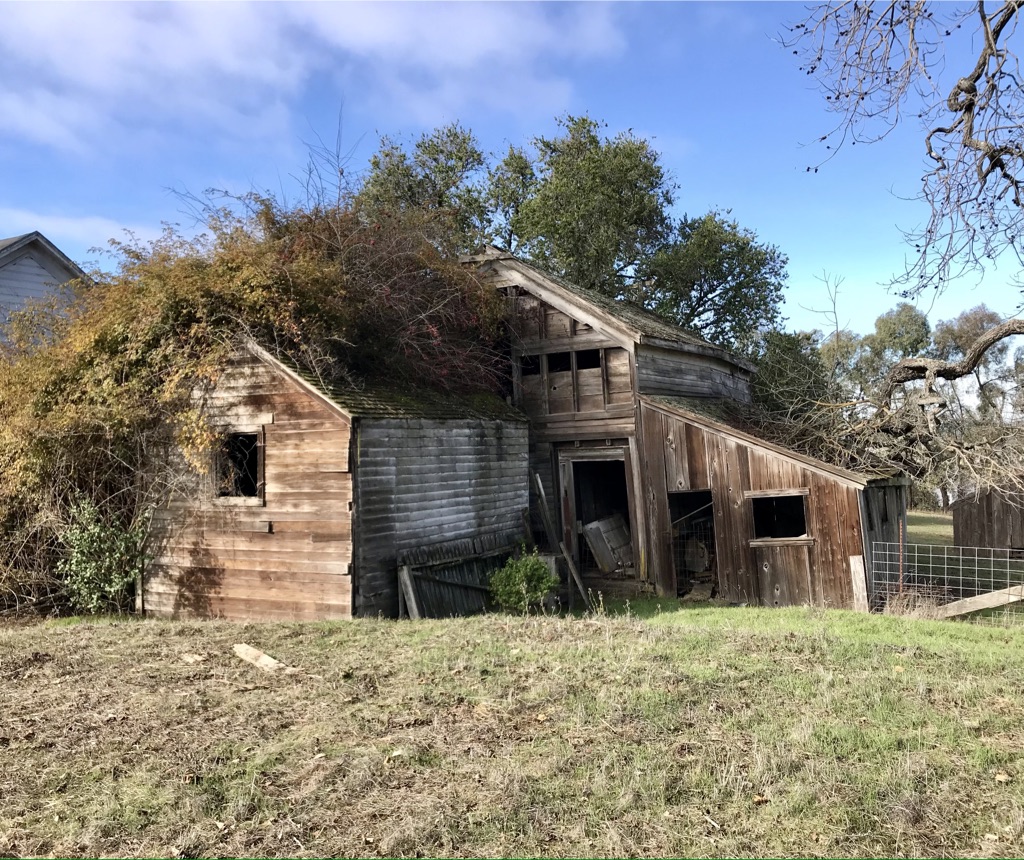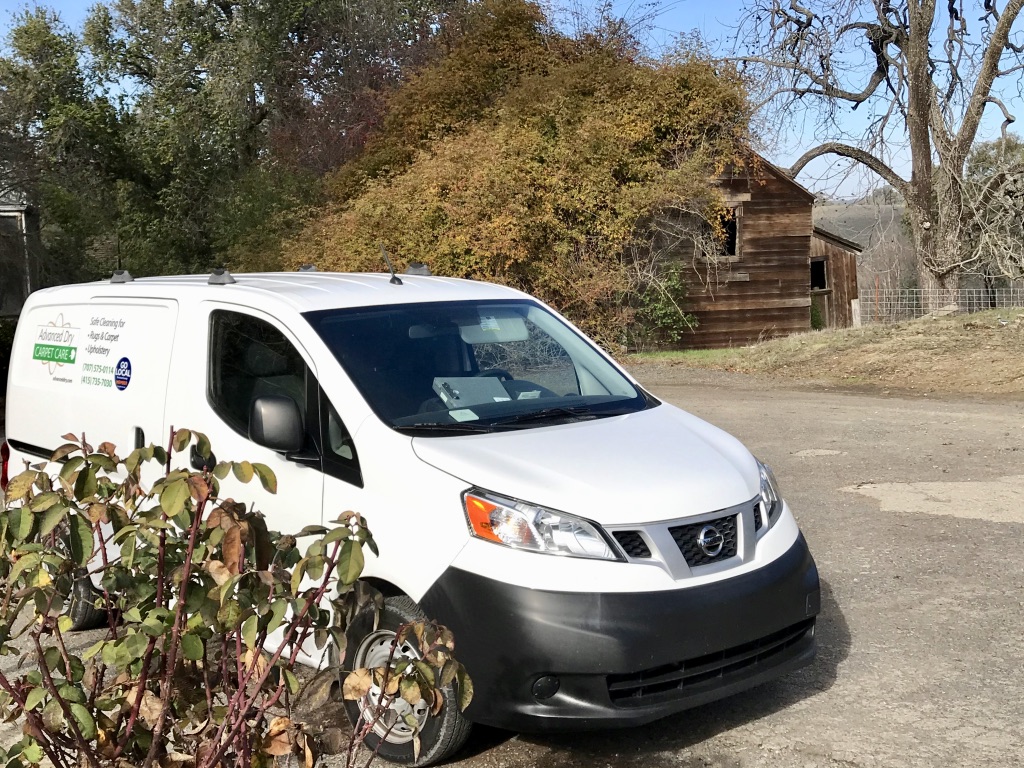Called to clean the carpet in a modular home east of Petaluma, I found myself on the historic homestead of Rev. Lorenzo Waugh. People throughout California called him “Father” Waugh. The tenant gave me permission to take pictures of these historic buildings.
I knew the name because of the Waugh School District (Meadow School and Corona Creek School) which my children attended and the original Waugh School building which is now a private residence on the corner of Adobe Road and Corona Road, east of Petaluma. I knew Father Waugh was a Methodist minister and a Petaluma pioneer during the gold rush years. Waugh had no interest in gold. Instead he found treasure in the people, animals and natural surroundings of the Petaluma Valley.
About this home, Waugh wrote in his memoirs:
On the homestead he gave me, I still have a most lovely little home, and which I expect to enjoy, with God's blessing, until, as I humbly trust, I shall be called to enter that building of God — "an house not made with hands, eternal in the heavens." And may General Vallejo and I be near enough in the new country and the eternal habitation, to often hold a communion season together.
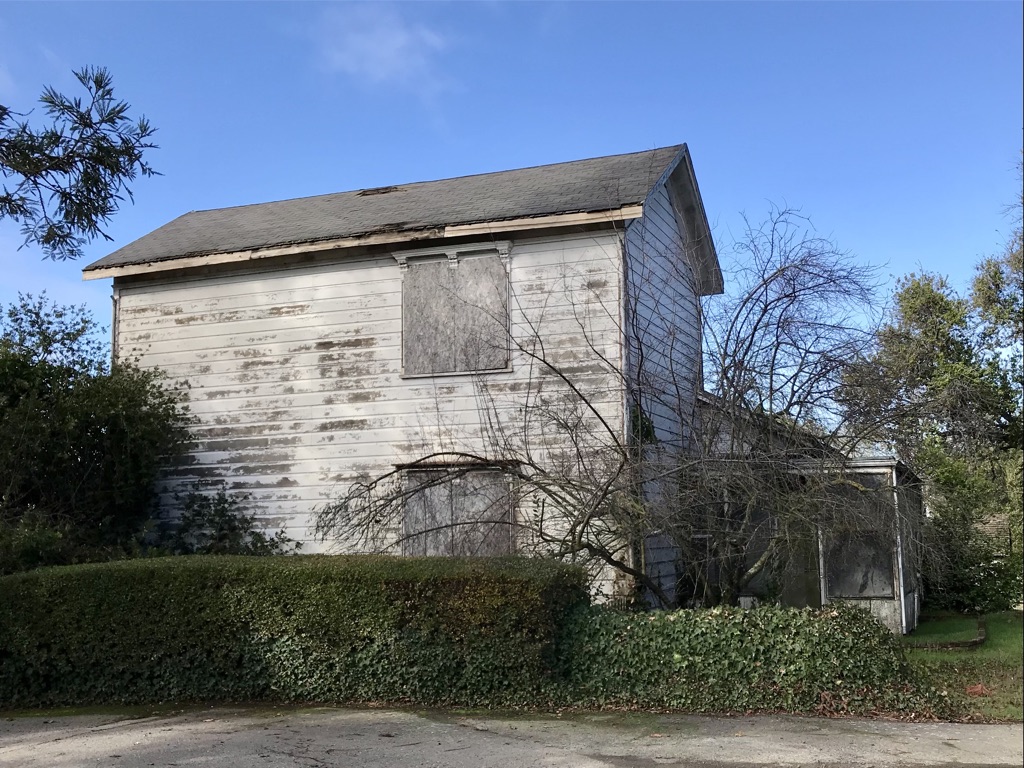
Lorenzo Waugh was born on August 28, 1808, near Greenbrier River, West Virginia, in what is now Pocahontas County. His parents must have loved football because they made a team: six girls and six boys. “Ranzy” as he was called by family and friends, was the oldest son. At age 16, he became a teacher in Harrison County. In 1831, he taught school in West Virginia, Ohio and Missouri. In Missouri he taught in a school for Native American children. He also became a circuit riding preacher. Waugh married Clarissa Jane Edsel in 1841. “I married a wife, Miss Clarissa Jane Edsall, who has proved to be a quiet, industrious, faithful woman, a good housekeeper, and a kind, affectionate mother to our children,” he wrote in his memoirs. When the health of both failed, they made an adventurous journey over the plains in 1852 to California with ox teams.
The Waughs settled five miles north of what would later be Petaluma and built a small house with lumber from nearby Redwood forests. He then set about to find out who owned the property (good idea) and how he might take ownership of the land, which led him to General Don Mariano Guadalupe Vallejo (1807 – 1890). Waugh regaled Vallejo with stories of ministry with Native American children and Vallejo assured him he could have the land if a survey showed that Vallejo owned it. Titles were not very specific in those days and there were numerous disputes that had to be settled in court. Long story short, the land was sold when Gen. Vallejo was out of the area and the new owner evicted Waugh. After another meeting between the two, the general granted Waugh a half section of land – 320 acres – at the intersection of Adobe Road and Corona Road. That’s where Waugh built a second home, pictured above. “Land is plenty. and it for us, and I have plenty of it yet,” said the general. Since no church had been built, their new home was made available for preaching, social and religious gatherings for all in the region.
The Waughs brought three children with them to California and had two more in California.
- John Waugh
- William Waugh
- Henry Clay Waugh
- Elizabeth D Waugh, born in Petaluma in 1852, who married Capt. George A Allen.
- Franklin Carpenter Waugh, born in Petaluma, died at age 10.
Having regained his health, Waugh considered a return to teaching and preaching, but decided it was not a good idea, considering his age (he was about 40) his family and “the old fact of being a little below the present needful grade in education)”. For his next career, Waugh settled on preventing youth from falling victim to the vices of the day, particularly tobacco, strong drink and foul language.
But soon I did see the thing I should do, and my way perfectly clear and plain; namely, to go out and talk, and work, and be a proper example among the children and youth... I saw, too, the dreadful moral dwarfage, sin, and shame prevailing almost everywhere, induced by vicious habits begun among the children by the practice and example of those who should know better, and act otherwise, the poisonous, filthy use of tobacco, drunkenness, and profanity, with all their legitimate train of sin and misery.
Father Waugh headed the Petaluma temperance movement for many years. He helped organize the California Youth Association in 1859. He also built the first Methodist Church in Petaluma. I wrote about the Women’s Christian Temperance Union (WCTU) and the drinking fountain, 1891, that still stands on Western Ave at Petaluma Blvd HERE.
Father Waugh would take pride knowing that smoking (and drinking) is absolutely prohibited in or near the two schools that are part of the Waugh School District. He would be greatly concerned, however, to hear the foul language of children at recess.
Rev. Waugh died at the Williams CA train depot, September 5, 1900 at the age of 92. He was on his way to visit his daughter-in-law in the hope that the climate would be better for his health. His body was taken to Petaluma. A gravestone in Cypress Hill Cemetery marks his burial (see below).
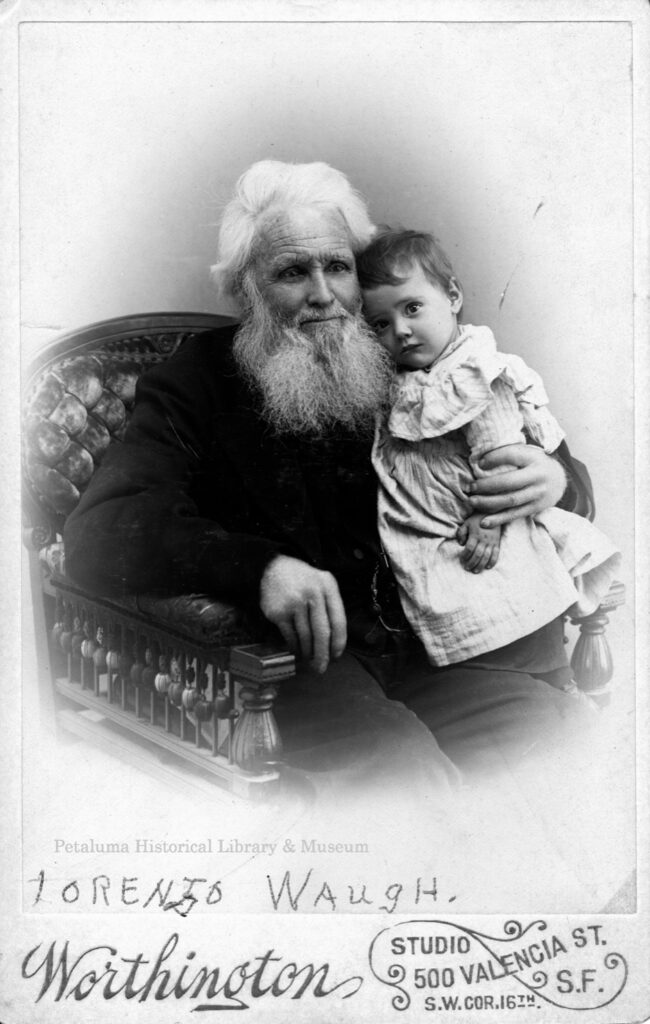
Petaluma Historical Library and Museum
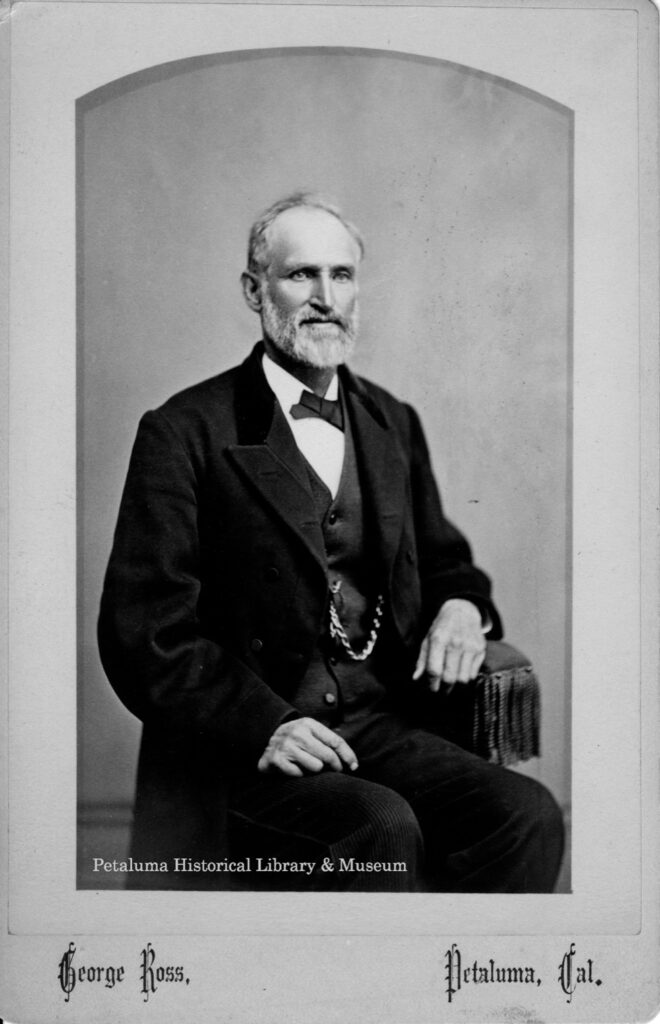
Petaluma Historical Library and Museum
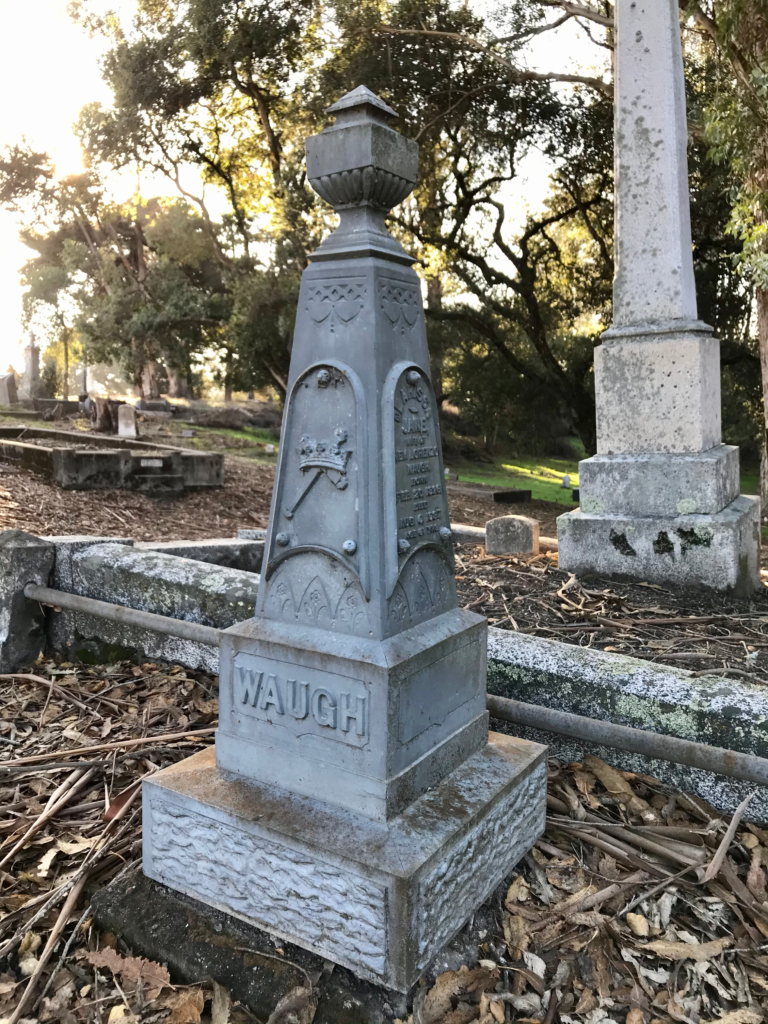
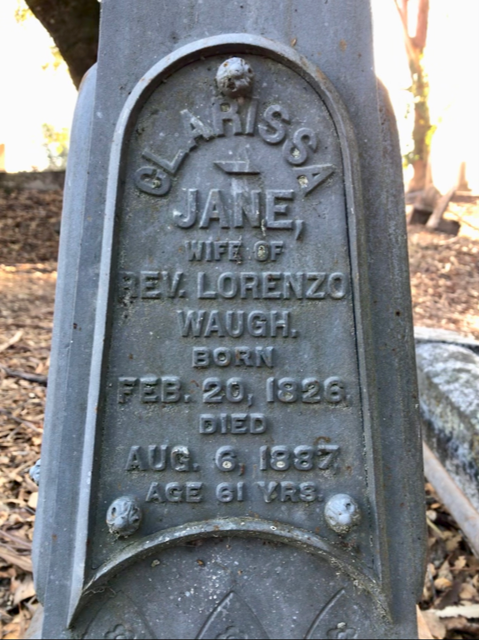
You can read Rev. Waugh’s autobiography HERE for a glimpse of life on the western frontier – interactions with pioneers of the North Bay, camping trips, confrontations with bears, mountain lions and coyotes, teaching Native American children and church planting in Petaluma. His 32-chapter autobiography is a delightful read, even though he wrote primarily for his children and grandchildren. It includes many of the poems he wrote. He particularly loved acrostics. The book was published in 1883 and had five printings. Waugh felt that he found his own Eden in the North Bay and his love of the area shows throughout the book.
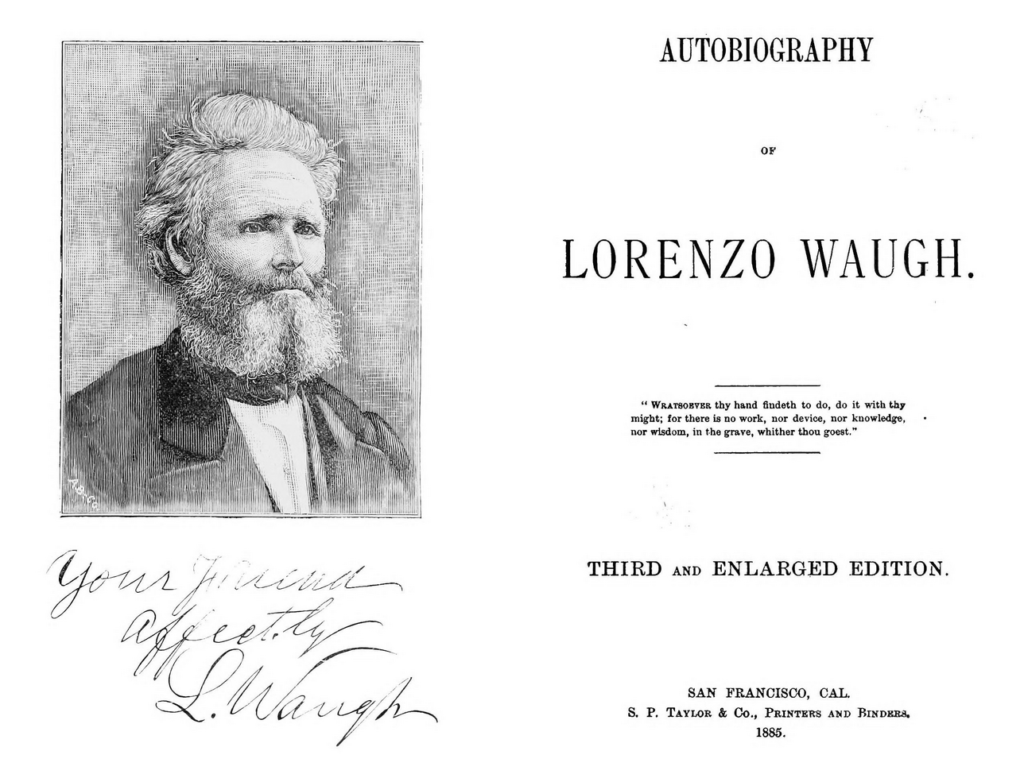
Camping and Hunting in the North Bay, pages 247-249
A well-arranged camp-out in California is really a rational and delightful thing... We will start out with one of 1870. Here we are with two well-fitted-out spring wagons, a span of good horses to each. In these are two tents, plenty of blankets, change of raiment, the substantials of provisions — flour, crackers, bacon", hams, canned meats, pickles, dried fruits, sugar, coffee, tea, salt, pepper, mustard, etc. — with cook- ing and eating utensils just enough... Well, all in readiness — guns, ammunition, fishing- tackle, all and everything — the first night out we camped on the beautiful timbered ridge over-looking Russian River. Supper over in good time, all were soon sound asleep in tent, as from the little extra exertion in starting, and the day's travel, to rest and sleep were delightful. Along in the night, the voice of Mrs. Hittell was heard : " Theodore, Theodore, there is a California lion out there ; get your gun." " O," says the Senator, " never mind the lions, I am so sleepy." " You get your gun ; I tell you that lion will jump in here and take Katie." " O," says the Senator, " Lew is lying here next the door. If the lion comes in, it will take Lew." " No," said Mrs. Hittell, " it will not do that Lew is old and tough, and Katie is young and tender. Get your gun, I tell you." Then by this time all were wide awake, and the idea of Lew being safe because he was old and tough convulsed all into a roar of laughter — Lew joining' in most heartily. We moved the next day beyond the Russian River into the great redwood grove which then stood there, almost untouched by the cruel axe-men, covering the bottom and hill-side lands along the Austin Creek. Some, soon after stopping, were seen measuring around the base of some of those redwood trees, some of the trees requiring a twine over thirty feet to reach around...
On his spiritual beginnings (age 15) pages 54-55
In this condition of mind I went to church, to the same place where I had heard Elder Morgan preach — a kind of protracted revival meeting. There. I saw some who professed to .be converted, and made happy. And there I felt the clear conviction of mind that it was my duty, and without any further delay, to seek God and to obtain, if possible, a release from the guilt of sin, and the renewal of my fallen, corrupt nature. God had blessed others, could he, would he not also help me? I knew the blessed invitation of the Saviour as he had said, "Come unto me all ye that labor and are heavy laden, and I will give you rest." I believed he had saved others, even the thief on' the cross, and would he not save me — have me from the guilt and power of sin and from the fear of death and hell? And then and there I wrestled and pleaded for power to yield, and for power to lay hold of the atoning, risen, living, interced- ing Saviour. And I shall always believe I did then obtain the blessing the Christian people call the "new birth." I was surely " born again," born into a new life. My whole .being seemed to be changed. I was happy, and all the people looked to me as though they were happy. My happiness, too, was such as I had never experienced before. Sometime after this, however, I received another bless- ing, or holy baptism of the spirit, still more wonderful and powerful than the first. I still remember its blessed and glorious effects upon me, yet I have no means to describe it to you. It was clear, sensible and powerful. I knew that I was indeed in Christ Jesus a new creature, old things being passed away and all things become new. These blessings, allow me to say, children, I never have yet lost, though I have at times wandered some and had some " backslidings," as the Christian people used to say; still I have kept hold of the same Almighty help, and so amidst all the changes and vicissitudes falling to my lot in this checkered life so far, I am this day still happy, and God in Christ Jesus is my trust and Heaven my intended and unwaveringly hopeful home.
Cross-posting:
Reddit – #reclaimedbynature
Read about another Methodist minister, whiskey-barrel preacher and church-planter, Rev. William Taylor of San Francisco in my blog post for Grace Community Church San Francisco. Revs. Taylor and Waugh were contemporaries and likely knew each other. Each planted the first Methodist church in their respective areas.
